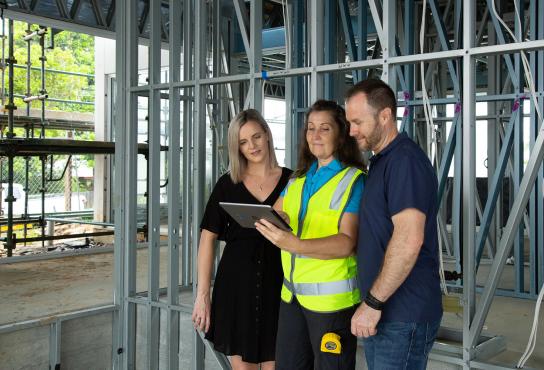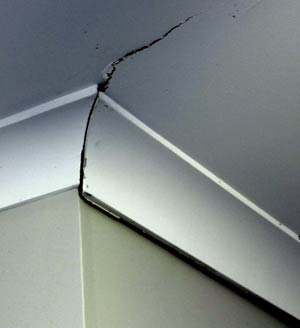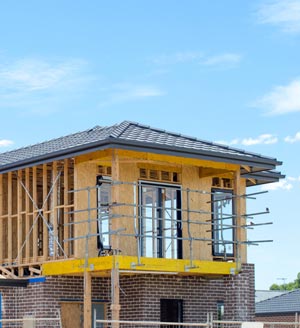
Homeowners: what you need to know for a build project
A home is one of the biggest investments you will ever make. We're here to help things run as smoothly as possible.
At the QBCC, we are responsible for regulating the Queensland building and construction industry, which includes (but is not limited to):
- ensuring proper building standards
- regulating building product supply chains to ensure safe and compliant building products
- providing dispute resolution services for defective building work
- licensing building and trade contractors, plumbers and drainers, certifiers and pool safety inspectors (excluding management of workers’ and contractors’ electrical licenses which is done by the Electrical Safety Office); and
- administering the Queensland Home Warranty Scheme (QHWS).
For more information about who we are and what we do visit About us.
Choosing a licensed contractor
The most important thing to remember when undertaking a building project is to use a licensed contractor, regardless of the size of the job.
Choosing a licensed contractor means you're working with someone who has met the criteria required to obtain a QBCC licence, including the requisite experience, qualifications and financial requirements.
Our licensees are also required to ensure any insurable building work worth more than $3,300 is covered by the Queensland Home Warranty Scheme (QHWS), which is another reason to choose them.
The QHWS can protect homeowners in the event of defective building work, non-completion of a fixed price contract, or if the work is affected by subsidence.
There is often a lot on the line for everyone involved in a build process, and if this is your first experience engaging in this process you may not know the signs to look out for that all is not going as well as it should be.
If you receive a request for extra money outside of amounts agreed in the contract that are not due to legitimate variations and where no extra work has been performed, or you receive a request for money to be paid into a different account (that is not the account in the contract), this is a warning sign.
If you are receiving requests that differ from what is in your contract and you have questions, you should raise this with your contractor and seek an explanation and seek independent legal advice.
The same goes for if you find there are delays with hitting milestones, as per the build schedule. You should have a conversation with your contractor and seek an explanation for the delay/s, which may be due to materials or labour shortages. You may wish to seek independent legal advice.
What to do when something goes wrong
Most of the time, when new homes are built or renovations are completed the homeowners are satisfied with the work that’s been done. However, from time to time, things do not go according to plan. When your attempts to negotiate with your licensed contractor have failed, you may find yourself in dispute and in need of assistance from the QBCC.
Your complaint may involve a dispute with your licensed contractor, the build process, or it could be about unlicensed building work or another building-related matter.
While the information on this web page only applies to disputes with your licensed contractor or the build process, you can find out how to make other types of building-related complaints at Complaints and disputes.
The QBCC provides an equitable and effective dispute resolution service. This help ranges from providing advice, trying to facilitate an agreement between parties in a dispute about building work, directing the contractor to rectify defective building work, and providing access to the QHWS.
When you get into a dispute with your licensed contractor over work, it can be due to:
- inaccurate and/or incomplete documents
- poor communication
- delays and/or timeframes not being met
- quality of work.
It is good to try and mitigate these potential issues wherever possible by keeping lines of communication open and respectful, and keeping your own records.
To get help to resolve the matter, you may need to contact the QBCC. You can find out more at Defective work dispute.
In most cases, a dispute occurs when the homeowner is unhappy with the quality of building work and the licensed contractor disagrees or refuses to fix it. If your dispute is over building work, it will usually be due to non-completion, defective work, or subsidence.
Before lodging a complaint
Before making a complaint, you will be expected to have raised this issue with the licensed contractor and provided them with the opportunity to rectify or provide a response.
Give your contractor written notice of every defective or unfinished item (e.g. by email or letter). The notice must give a timeframe (e.g. 14 days) for the contractor to rectify the items (not required if they are bankrupt, liquidated, deregistered or deceased). We suggest that you are as descriptive of the issue and/or concern as possible and make sure a copy of the correspondence is kept for your records.
If there is no action and/or no satisfactory response, then you can lodge a complaint with the QBCC.
What happens next?
We play an impartial role in the dispute and favour neither the homeowner nor the licensed contractor.
You can help your complaint progress as quickly as possible by:
- ensuring you have already raised the issue with the licensed contractor and attempted to resolve it
- providing as much relevant information as possible
- including clear photographs of the alleged defective work.
When you lodge a new complaint with the QBCC, your complaint is assigned to an assessment officer who assesses the case and decides how to proceed. The assessment officer will then contact you and the licensed contractor in an effort to resolve the matter. If the matter cannot be resolved, the assessment officer is likely to allocate the case to a building inspector.
The building inspector who has been allocated your case will contact you and the licensed contractor and may schedule an inspection.
When there is a dispute, we encourage you and the licensed contractor to continue to communicate and attempt to resolve the issue/s.
We will always encourage you both to try to resolve the matter as quickly as possible, as we understand the stress you both experience when this does not happen.
Strict time limits apply for cover and claims
Insurance cover on a property has a limited lifespan. Similarly, claims must be made within certain time frames. This can be as early as 3 months from when the contract ends or you notice a defect. Ensure you are familiar with the time limits for cover and claims.

Types of building work issues
Click on a type to learn more
-
When determining whether building work is defective, the building inspector will consider the work against the National Construction Code, Australian Standards, manufacturers’ guidelines, and QBCC's standards and tolerances guide which outlines the relevant standards and any associated tolerances for different building work.
The building inspector carries out the inspection, and usually gives one of four outcomes.
Outcome 1—no defect, no direction issued
If it is determined that no defect is present, then no direction can be issued.
Outcome 2—defect found, direction issued
Direction to Rectify – A Direction to Rectify is issued for all or some aspects of the work. The licensed contractor usually has 35 days to comply with the direction.
If they do not satisfactorily complete the work which is the subject of the Direction to Rectify, it will be considered a failure to rectify the defect and regulatory action may be taken against the licensed contractor.
If the work is insurable work, the case may then be referred for assessment of a claim under the QHWS. Some work is not insurable. For more information about the QHWS, including limitations, visit Queensland Home Warranty Scheme.
Normally, a scope of work will be prepared and provided to a panel of contractors. The successful licensed contractor will enter into a contract with you to complete the rectification work.
As the homeowner, you will be engaged throughout the QHWS process and consulted before the scope of work is finalised.
The time it takes to complete rectification work is dependent on availability of materials and the scope of work required.
Outcome 3—defect found, no direction issued
Defect is present, however no Direction to Rectify is issued if, in the circumstances, it would be unfair to give a direction. For example, monies withheld from the contractor, the homeowner fails to allow the contractor to return to rectify the defect, and/or the homeowner’s failure to maintain the property has exacerbated the defect.
Outcome 4—contractual dispute
While we may be able to offer some assistance when it comes to contractual matters, as part of our early dispute resolution process, we don't generally get involved in disputes over contractual matters and this is the most common reason for a complaint not to proceed. Additionally, the QHWS does not cover items where the dispute is considered contractual rather than defective work.
Contractual matters include issues with payments, variations and delays, whereas defective work relates to concerns over the quality of the building work which can be assessed against the QBCC’s standards and tolerances guide.
Examples of disputes that are considered contractual and not covered by the QHWS include:
- roof tiles are the wrong colour
- type of door installed is different to what was agreed
- disagreement about cost to change handrails from timber to steel
- dispute about delays in finishing laying floor tiles.
-
Both homeowner and licensed contractor can apply for a review of a decision to issue a Direction to Rectify or a decision not to issue a Direction to Rectify, using the QBCC’s internal review process. It should be noted that a review may delay the process by a further 28 days.
After the Internal Review Unit makes a decision, if the homeowner and/or licensed contractor are dissatisfied with the internal review decision, either or both parties can review the internal review decision at Queensland Civil and Administrative Tribunal (QCAT).
For more information on how to have a QBCC decision reviewed or what happens if the other party in your dispute requests a review of a QBCC decision visit Review of a QBCC decision.
-
Non-completion of building work occurs where a licensed contractor has failed to complete all work under a fixed price contract for residential construction work.
You can lodge a non-completion claim when a licensed contractor does not finish the work they were contracted to do, because:
- they are insolvent (e.g. bankruptcy for am individual or administration or liquidation of a company
- death of a contractor
- you validly terminate the contract (PDF) due to the default of the contractor.
-
We can only process a claim for non-completion under the QHWS if your contract is lawfully terminated. Note, you do not need to terminate your contract if the contractor:
- passes away
- is a company that has been deregistered
- had their licence cancelled and are insolvent.
DO NOT try to terminate the contract yourself if the contractor has defaulted in some other way.
You should get legal advice to see whether you can and should terminate your contract. You can find a solicitor to help you by contacting the Queensland Law Society.
Terminating a building contract for any reason is a very serious matter that may, if not done properly, cause major financial and legal problems for a party wrongly terminating. For a homeowner, failure to properly terminate your contract may result in not being entitled to a claim under the QHWS administered by the QBCC (e.g. cover for non-completion may not be available).
It is STRONGLY RECOMMENDED homeowners and contractors obtain formal legal advice before taking steps to terminate their building contract.
For more information visit Terminating a building contract and How to terminate a building contract – fact sheet.
-
Subsidence may occur when soil type, location and the water content of soils cause building foundations to move. If one part of the ground beneath a building moves more than another part, the building may crack.
If you think your property has been impacted by subsidence, you are encouraged to lodge a complaint for defective work.
-
When you make a complaint about subsidence, we will need to investigate to determine the cause of the subsidence.
We may need to engage an engineer to undertake inspections to determine the extent of the issue. It may also be necessary for a series of inspections to occur over a period of time to enable the engineer to identify whether the movement of the ground has impacted the building work in excess of the limits contained within the standards and tolerances guide. This can take some time to resolve.
Queensland Home Warranty Scheme (QHWS)
At the QBCC, we administer the QHWS which is a not-for-profit scheme funded through premium payments. Home warranty insurance is a premium your contractor pays to the QBCC to insure residential construction work for fixed-price and cost-plus residential contracts.
The premium amount is:
- collected from you and paid to the QBCC by the contractor
- included as part of your contract
- paid before work begins
- compulsory for all residential construction work valued at more than $3,300 (including cost of materials, labour and GST).
Like all forms of insurance the QHWS has limitations and exclusions.
The QHWS covers homeowners for insurable building work that is defective, incomplete, or where the property experiences subsidence.
Work that is not insurable building work may be covered for non-completion (where it is performed as part of a contract for primary insurable work), but will not be covered for defects. This means that if it is part of a larger build (for example, a driveway for a new home that is being built), then it may be covered if the project is not completed. However, any work that is not insurable on its own would not be covered for any defective work claims that may arise down the track. This work includes, for example:
- driveways
- paths
- roads
- fences
- air conditioning
- hot water systems
- security doors and grilles
- landscaping.
- earth moving and excavating
- laying asphalt or bitumen
- fire alarm systems
- floating floors and carpets
- insulation
- some work associated with the erection, construction or installation of the swimming pool, for example:
- non-structural defects in swimming pools
- surfacing of an area outside the coping for the swimming pool
- paving
- supplying or installing water features, swimming pool slides, diving boards and swimming pool equipment and housings
- steps for the swimming pool that are not fixed structures
- any work valued less than $3,300 (including GST, labour, materials).
To make a claim or for more information visit Claim home warranty insurance.
Strict time limits for Qld Home Warranty Insurance claims
You MUST report defective building, incomplete work (non-completion) and subsidence to the QBCC within strict time limits. Failure to report the issue within this period will result in a claim being refused.
Find out Time limits for cover and claims and how they apply for your situation.



